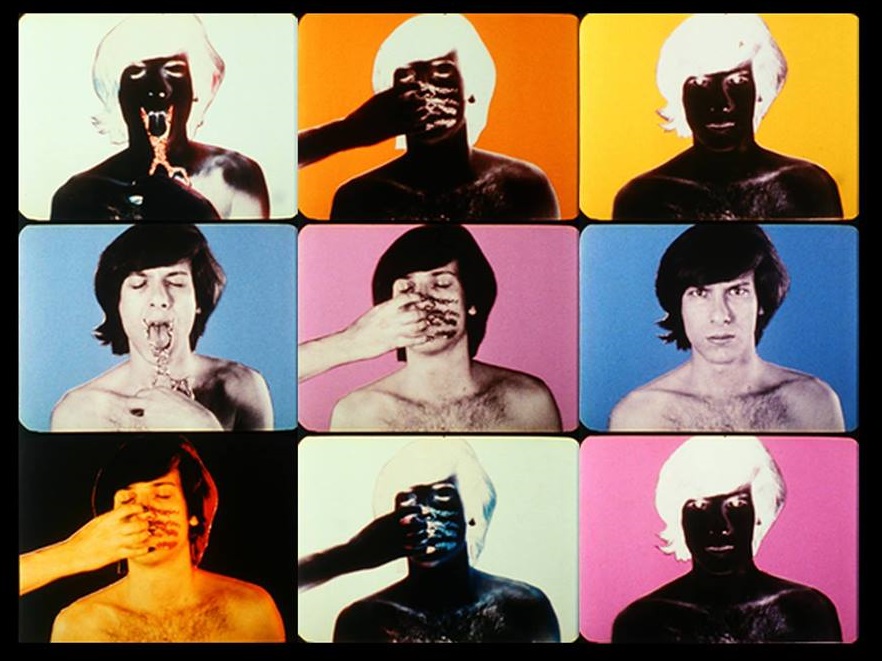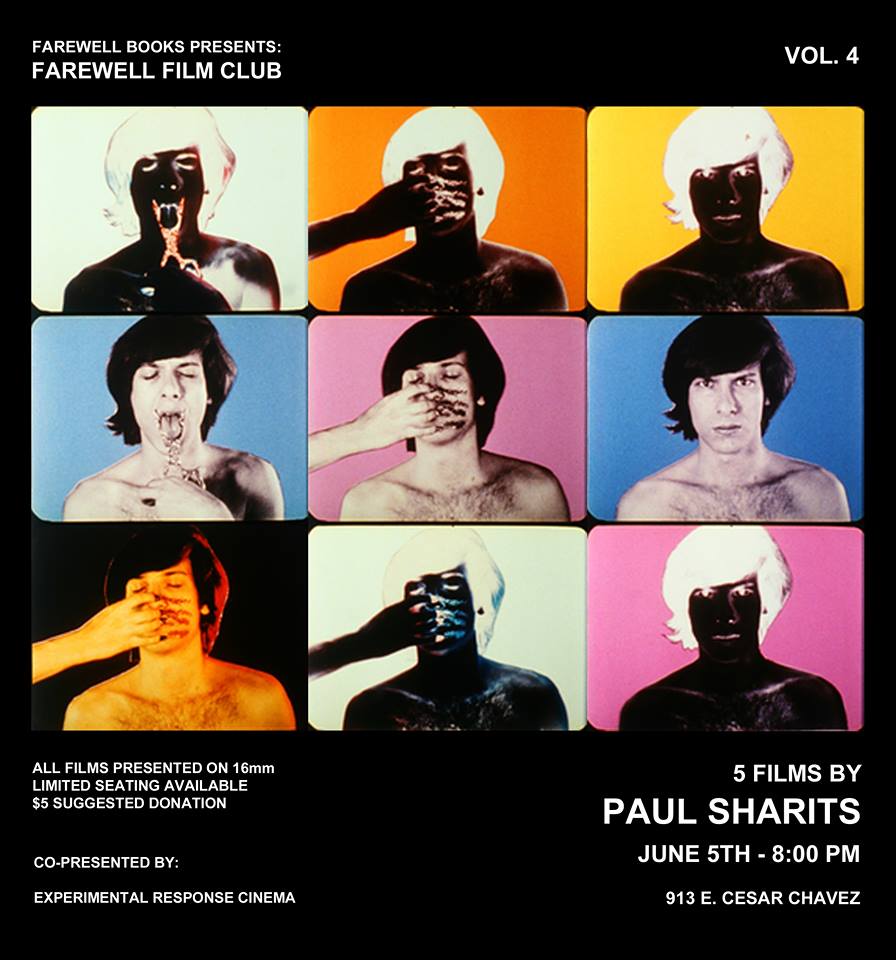June 5th, 2014
@ Farewell Books (map)
8:00pm
$5 Suggested Donation
Farewell Books is proud to present this rare program of 16mm works by one of the most innovative figures of American Avant-Garde Cinema. Born in Denver, Colorado in 1943, Paul Sharits was a multi-disciplinary artist known for his contributions to various experimental film forms such as structuralism, installation and expanded cinema.
Sharits earned his BFA at the University of Denver under the tutelage of Stan Brakhage, who was an early supporter of the young artist. Although he received modest recognition at first, Sharits was highly regarded by many of his older and more famous contemporaries such as Hollis Frampton, Michael Snow, and of course Brakhage. Looking back at his work almost 50 years later reveals an artist who was radically ahead of his time.
Throughout his life, Sharits struggled with severe bi-polar disorder which can be seen reflected in his aesthetic. Sharits’ films are a cinema of duality. His work is at once aggressive and meditative, minimal and complex, violent and beautiful, but always mesmerizing and technically masterful.
Sharits’ works have been exhibited at MoMA, Centre Pompidou, Green Naftali Gallery, and many other world-renowned arts institutions. Please join us for this special presentation of some of his most groundbreaking and transcendent works.
Co-presented with Experimental Response Cinema.
Farewell Books, founded in February 2013 and run by Travis Kent & Mikaylah Bowman, is a progressive new and used bookshop and art gallery in the city of Austin, Texas. Farewell Film Club is programmed by Hunter Shaw.
Program
Ray Gun Virus
14 min / 16mm / sound / 1966
Although affirming projector, projection beam, screen, emulsion, film frame structure, etc., this is not an “abstract film”/projector as pistol/time-colored pills/yes=no/mental suicide and then, rebirth as self-projection. “… just colors and strobe … ‘light-color energy patterns (analogies of neural transmission systems) generate internal color-time shape and allow the viewer to become aware of the electrical-chemical functionings of his own nervous system’ … It’s true.” – David Curtis, International Times “RAY GUN VIRUS is a work in which no images appear yet one can get pure identity on film. … projected film itself makes the viewer aware of where he stands. RAY GUN VIRUS is not so-called ‘Psychedelic Cinema’ but even more and goes beyond it through Sharits’ bright clarification of the media.” — Takahiko Iimura, Film Art Exhibition: Fourth Int’l Experimental Film Competition, Knokke-Le-Zoute; “Twenty Years of American Personal Film” anthology, National Museum of Modern Art, Tokyo, 1966. Collections: Museum of Modern Art, NY; Royal Archive of Belgium.
Piece Mandala / End War
5 min / 16mm / sound / 1966
Soundtrack by Bob Grimes. Blank color frequencies space out and optically feed into black and white images of one lovemaking act which is seen simultaneously from both sides of its space and both ends of its time. “Thanks for the strip … it IS that/cut to the bone of some matter that does really concern me: how a man and a woman meet nakedly head-on among the colors … lovely: I can hardly wait to see the entirety of that vision ….” — Stan Brakhage “PIECE MANDALA/END WAR reminds me very much of the back light (GoKo) which illuminates the spirit of Buddha — yet no image of Buddha appears; rather, a couple of naked bodies. I have never imagined that GoKo could really happen and illuminate as in this film.” — Takahiko Iimura, Film Art
T,O,U,C,H,I,N,G
12 min/ 16mm /sound / 1968
Starring poet David Franks whose voice appears on soundtrack/an uncutting and unscratching mandala. “Merges violence with purity.” — P. Adams Sitney “Surrealist tour-de-force.” — Parker Tyler On “10 Best Films of 1969” lists of Soren Agenoux and Jonas Mekas.
Inferential Current
8 min / 16mm / sound / 1971
A mapping of an image of the linear passage of “16mm film frames” and “emulsion scratches” onto an actual 16mm film strip (the unperceived film “print”) / the aural word “miscellaneous” is extended to a length of eight minutes by serial fragmentation, looping, staggering and overlaying / a variational but non-developmental strand thru time. / Dedicated to Lynda Benglis. “Like S:S:S:S:S:S, INFERENTIAL CURRENT is concerned with the movement of film through the projector and with the distinction between the film strip itself and its image, as it appears on the screen. In this film, the image is that of a whole film strip, with sprocket holes. The movement of the sprocket holes shift speeds and creates illusions of motions (reversals of direction, etc.) but also alludes to the motion of the actual movement of the actual film going through the projector. There is an inter-play of two generations of vertical scratches, which provides an ironic effect.” — David James, Art & Cinema
Bad Burns
6 min / 16mm / sound / 1982
Two reels of mis-takes in shooting Part II of 3RD DEGREE. Film was loaded in camera improperly and the image slides about off-center and becomes blurred — creating some rather amusing and mysterious imagery. A made “found” object.
Bio
American avant-garde “experimental” filmmaker, artist, and professor of media studies, Paul Sharits was born in Denver, Colorado on February 7, 1943. Tragically, he died on July 8, 1993 in his home in Buffalo, NY. He is survived by his son, Christopher, Christopher’s wife Cheri, and three grandsons.
Paul is widely known for his structural films, the use of multiple projectors, infinite film loops, experimental soundtracks, and interventions at the level of the filmstrip in order to realize his elemental mode of cinematic presentation. Paul went to The University of Denver’s School of Art (DU) where he earned a BFA in Fine Arts. At the time he was known as a young painter, however, he had been making films since high school. While studying art at DU, he began a mentorship with Stan Brakhage that soon became a lifelong friendship. Stan’s manipulation of film structure through experimental and “scratch” film’s influence is evident in Paul’s early work.
In 1964, he attended Indiana University in Bloomington, Indiana for his MFA in visual design. After he received his MFA, he moved his family which consisted of his son, Christopher, and his wife, Frances, to Baltimore, Maryland where he taught at The Maryland Art Institute. Later, he taught at and became a pinnacle force behind the development of the Center for Media Studies at Antioch College in Yellow Springs, Ohio. He divorced his wife in 1968. Shortly thereafter, he was recruited by Dr. Gerry O’Grady at The University of Buffalo Center for Media Studies along with the most prominent emerging experimental filmmakers of the time which included James Blue, Hollis Frampton, Tony Bannon, Tony Conrad, and later, Peter Weibel.
Paul enjoyed relative acknowledgement during his lifetime, with shows at the Bykert Gallery, Albright-Knox Art Gallery, and Walker Art Center among other institutions, and has been posthumously exhibited at the Whitney Museum, MoMA, Pompidou, Louvre, and the Burchfield-Penney Art Center in Buffalo, New York as well as the widely renowned Greene Naftali Gallery exhibition of both his works on paper and his four projector installation “Shutter Interface” which was nominated for “Solo Exhibition of the Year” at the 2009 First Annual Art Awards at the NYC Guggenheim Museum. The four projector “Shutter Interface” installation was acquired by and is now on exhibition in the Smithsonian’s Hirshhorn Museum in Washington, D.C.. Trained initially as a painter, and a prolific theoretical writer, Sharits’ art-making was in fact wide-ranging, evidenced by his early involvement with Fluxus artists in New York. His many works on paper-from diagrams to abstract film scores, fashion drawings, and hallucinogenic illustrations-have yet to be fully integrated into his better-known body of work. (Christopher Sharits, 2010)

